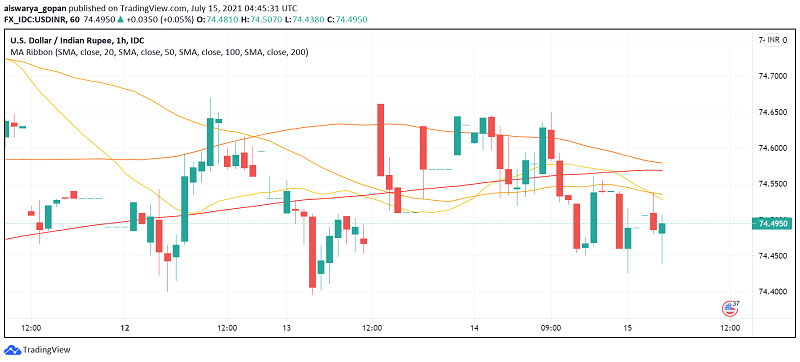The Indian rupee is the national currency of India, which is also referred to as INR. However, the INR is usually represented with the symbol ₹. The Indian rupee (INR) derives its name from the rupiya, a silver coin first issued by Sultan Sher Shah Suri in the 16th Century. For the time being, the issuance of the currency is controlled by the Reserve Bank of India. Managing currency in India could be considered as one of the most important tasks of the Reserve Bank of India. Moreover, India’s reserve bank also plays an important part in the Development Strategy of the Government of India, issues statements, and decides on the interest rates of the country.
From a historical point of view, the new rupee sign (₹) was officially approved in 2010. D. Udaya Kumar created it, by combining the Devanagari consonant “र” (ra) and the Latin capital letter “R”, without its vertical bar (similar to the R rotunda). The first series of coins with the new rupee sign were issued on July 8, 2011. Before that, India used “₨” and “Re” as the symbols for multiple rupees and one rupee.
While talking about the coins, let me remind you that India’s coins are issued in denominations of 50 paise, one rupee, two rupees, five rupees and ten rupees.
Therefore, the paise is worth 1/100th of a rupee. Coins worth 50 paise are referred to as small coins, while coins equal to or above one rupee are known as rupee coins.
In terms of banknotes, the paper currency or banknotes in India are issued in denominations of 5, 10, 20, 50, 100, 500 and 2,000 rupees. It is worth mentioning that the denominations are printed in 15 languages on the reverse side of paper rupees. On the front, the denominations are printed in Hindi and English.
Typically, India’s banknotes are updated with new designs, including distinct differences between the old Mahatma Gandhi Series of banknotes and the new ones of the same name. The notes show various themes from India’s rich culture.
What is the USD/INR (US Dollar/ Indian Rupee)?
The USD/INR stands for the US dollar versus the Indian Rupee (USD/INR) currency pair, which tells the trader how many Indian Rupees (the quote currency) are needed to purchase one US dollar (the base currency). For example, if the market price of the USD/INR is 716, then around ₹71 is required to purchase 1 dollar. As already mentioned, the Rupee is symbolized by ₹. It is interesting to note that the INR is the 20th most traded currency worldwide.
It is also worth mentioning that the USD/INR currency pair normally trades from Sunday evening to Friday afternoon in many countries, offering useful opportunities for the traders. However, you can trade calls and put options on the pair. There is no delivery of the dollar, and the difference in exchange is done in INR. The nature of trading is European style. The option can be exercised upon expiry or squared off during the month. If the US dollar gains strength against the Rupee on or before expiry, then the buyer of the call option gains. A buyer of the put option gains on a weaker dollar and loses on a stronger US dollar.
Major Factors that Influence the USD/INR Currency Pair
The value of the USD/INR currency pair is mainly affected by geopolitical and global sentiment, like many emerging market currencies, as the foreign players have been withdrawing from the Indian equity market, which has contributed to the fall of the Indian rupee. The prevailing US-China trade situation seems to be having a domino effect on global trade, which has been affecting the Indian currency since Sep 5, 2019.
Across the pond, the INR has a strong correlation with the crude oil prices, as WTI Crude accounts for a significant portion of India’s overall imports. Thus, any rise in the price of crude oil hurts the economy. If WTI Crude Oil prices rise further, it will not only impact the stability of the rupee and the rise in stock markets. It could also produce an inflationary effect.
Current USD/INR Price: $
Historical Data Table:
USD/INR Historical Price Data
| Date | Price | Open | High | Low | Change % |
|---|
Monthly Change
| Date | Price | Open | High | Low | Change % |
|---|
Factors impacting the USD/INR Prices:
Many factors can impact the INR currency exchange rate, including trade flows, investment flows, and oil prices. India imports oil, and a rise in prices can cause inflation and force the RBI to intervene, in order to support the economy.
Interest Rates:
As we have already mentioned, higher interest rates in an economy tend to draw foreign investment, increasing the demand and value of the home currency. Likewise, lower interest rates tend to undermine exchange rates. By raising interest rates, the central bank can lower the demand for such goods, putting pressure on prices as a result.
Crude Oil:
WTI Crude Oil prices could also be considered one of the major factors affecting the prices of the Indian rupee (INR), as crude accounts for a significant portion of India’s overall imports. Thus, the rise in the price of crude oil hurts the economy. If WTI Crude Oil prices rise further, it will not only impact the rupee’s stability and the rise in stock markets, but it may also produce an inflationary effect
Economic Data:
The economic data, such as the Consumer Price Index (CPI), Gross Domestic Product (GDP), Trade Balance, Retail Sales, Consumer Price Index and Industrial Price Index have a great influence on USD/INR prices. This data is important if one is to understand the stock market, and especially the direction of the INR.


